
The goal of this article is to teach you how to use price to earnings ratios (P/E ratios). To keep it practical, we'll show how O2 Czech Republic a.s.'s (SEP:TELEC) P/E ratio could help you assess the value on offer. Based on the last twelve months, O2 Czech Republic's P/E ratio is 11.53. That is equivalent to an earnings yield of about 8.7%.
See our latest analysis for O2 Czech Republic
How Do I Calculate O2 Czech Republic's Price To Earnings Ratio?
The formula for P/E is:
Price to Earnings Ratio = Price per Share ÷ Earnings per Share (EPS)
Or for O2 Czech Republic:
P/E of 11.53 = CZK209.000 ÷ CZK18.125 (Based on the year to December 2019.)
(Note: the above calculation results may not be precise due to rounding.)
Is A High Price-to-Earnings Ratio Good?
A higher P/E ratio implies that investors pay a higher price for the earning power of the business. That isn't necessarily good or bad, but a high P/E implies relatively high expectations of what a company can achieve in the future.
How Does O2 Czech Republic's P/E Ratio Compare To Its Peers?
One good way to get a quick read on what market participants expect of a company is to look at its P/E ratio. We can see in the image below that the average P/E (16.2) for companies in the telecom industry is higher than O2 Czech Republic's P/E.

O2 Czech Republic's P/E tells us that market participants think it will not fare as well as its peers in the same industry. Since the market seems unimpressed with O2 Czech Republic, it's quite possible it could surprise on the upside. If you consider the stock interesting, further research is recommended. For example, I often monitor director buying and selling.
How Growth Rates Impact P/E Ratios
P/E ratios primarily reflect market expectations around earnings growth rates. When earnings grow, the 'E' increases, over time. Therefore, even if you pay a high multiple of earnings now, that multiple will become lower in the future. So while a stock may look expensive based on past earnings, it could be cheap based on future earnings.
O2 Czech Republic's earnings per share were pretty steady over the last year. But over the longer term (5 years) earnings per share have increased by 9.9%.
Don't Forget: The P/E Does Not Account For Debt or Bank Deposits
One drawback of using a P/E ratio is that it considers market capitalization, but not the balance sheet. Thus, the metric does not reflect cash or debt held by the company. The exact same company would hypothetically deserve a higher P/E ratio if it had a strong balance sheet, than if it had a weak one with lots of debt, because a cashed up company can spend on growth.
Such expenditure might be good or bad, in the long term, but the point here is that the balance sheet is not reflected by this ratio.
So What Does O2 Czech Republic's Balance Sheet Tell Us?
Net debt totals 14% of O2 Czech Republic's market cap. This could bring some additional risk, and reduce the number of investment options for management; worth remembering if you compare its P/E to businesses without debt.
The Bottom Line On O2 Czech Republic's P/E Ratio
O2 Czech Republic has a P/E of 11.5. That's higher than the average in its market, which is 8.1. With modest debt relative to its size, and modest earnings growth, the market is likely expecting sustained long-term growth, if not a near-term improvement.
Investors should be looking to buy stocks that the market is wrong about. If the reality for a company is better than it expects, you can make money by buying and holding for the long term. So this free visualization of the analyst consensus on future earnings could help you make the right decision about whether to buy, sell, or hold.
Of course, you might find a fantastic investment by looking at a few good candidates. So take a peek at this free list of companies with modest (or no) debt, trading on a P/E below 20.
If you spot an error that warrants correction, please contact the editor at editorial-team@simplywallst.com. This article by Simply Wall St is general in nature. It does not constitute a recommendation to buy or sell any stock, and does not take account of your objectives, or your financial situation. Simply Wall St has no position in the stocks mentioned.
We aim to bring you long-term focused research analysis driven by fundamental data. Note that our analysis may not factor in the latest price-sensitive company announcements or qualitative material. Thank you for reading.

